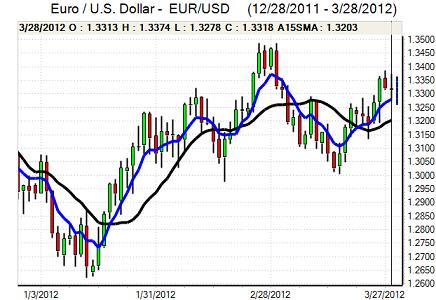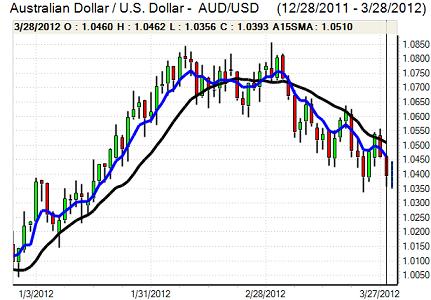EUR/USD
The Euro found support in the 1.3330 region in Europe on Wednesday and again rallied in an attempt to break resistance levels near 1.3380. In a similar pattern to the previous day, the Euro was unable to sustain the gains and retreated ahead of the US open.
The headline Euro-zone money supply growth data was slightly stronger than expected at 2.8% for February from 2.5% previously, but the private loans data was significantly weaker at 0.8% as bank lending remained weak. There was further evidence of net capital outflows from the Euro area which maintained underlying fears surrounding weak banks and the impact on the real economy.
There were further concerns surrounding the Spanish economy which also unsettled wider Euro-zone sentiment. There were denials that Spain was looking to request bailout funds for the banks, but there was also fresh speculation that the economy would eventually require some additional assistance given the scale of bad debts.
There were further signs that Euro-zone officials would move to expand the firewalls to protect peripheral economies, but Bundesbank Head Weidmann stated that the funds could only buy time and were not a permanent solution. There will be expectations that Euro-zone meetings from Friday will agree to strengthen the defences which underpinned the Euro.
Headline US durable goods orders rose 2.2% for February following a revised 3.6% decline the previous month while core orders rose 1.6%. There was some disappointment over the lacklustre recovery and some renewed speculation that the economy could be starting to falter again.
Equity markets were generally weaker which curbed risk appetite and there was some defensive dollar support as the Euro retreated to test support near 1.3280 before recovering back to the 1.3320 region. Quarter-end flows will have a significant impact and there was some speculation that portfolio adjustments would help underpin the dollar.

Source: VantagePoint Intermarket Analysis Software
Call now and you will be provided with FREE recent forecasts
that are up to 86% accurate* 800-732-5407
If you would rather have the recent forecasts sent to you, please go here
Yen
The dollar initially found support on dips to the 82.65 area on Wednesday and rallied to test support in the 83.20 area during the New York session despite a slightly weaker than expected durable goods orders report.
The Japanese currency regained some support later in the session as risk appetite was more fragile with equity markets weaker. There was also some speculation of additional year-end flows and capital repatriation ahead of the settlement deadline.
This trend continued in Asian trading on Thursday as equity markets remained on the defensive amid regional slowdown doubts. The latest retail sales data was stronger than expected with a 3.5% annual increase and the yen edged towards the 82.50 area.
Sterling
Fourth-quarter UK GDP was revised down to -0.3% from -0.2% previously which had a significant negative impact, especially as there was annual growth of only 0.5% with the economy basically stagnant since the Autumn 2010. There were further concerns over the implications of a decline in disposable income, but investment was revised slightly higher. The current account data did not have a major impact with a fourth-quarter deficit of GBP8.5bn from a revised GBP10.5bn previously.
There were renewed doubts surrounding the economic outlook and also some fresh speculation over the possibility of additional quantitative easing following slightly more dovish comments from Bank of England Governor King the previous day.
There was continuing pressure for a correction following the inability to break resistance in the 1.60 region and there was also a negative impact from weaker risk appetite. There was solid buying support near 1.5850 with the UK currency back above 1.59 on Thursday.
Swiss franc
The dollar found solid support on dips towards the 0.90 area against the franc on Wednesday and rallied to highs near 0.9080 before faltering again. The US currency was hampered by a further drift weaker towards 1.2050 for the Euro.
Fresh concerns over the Euro-zone outlook will tend to increase the potential for capital outflows into Switzerland, especially if Spanish fears intensify. The main impact may be to deter outflows which would tend to push the currency higher given the structural current account surplus.

Source: VantagePoint Intermarket Analysis Software
Call now and you will be provided with FREE recent forecasts
that are up to 86% accurate* 800-732-5407
If you would rather have the recent forecasts sent to you, please go here
Australian dollar
Australian dollar rallies were held in the 1.0450 region against the US currency on Wednesday and retreated to lows near 1.0350, the weakest level for over two months. The currency remained generally vulnerable on the crosses as the Euro and yen were able to advance.
There were further doubts surrounding the regional economy and weaker equity markets also had a negative impact. There was some speculation that the Reserve Bank could cut interest rates at next week’s policy meeting. There was further caution surrounding the regional growth outlook which kept the Australian dollar on the defensive in Asian trading on Thursday with tough resistance close to 1.04.



